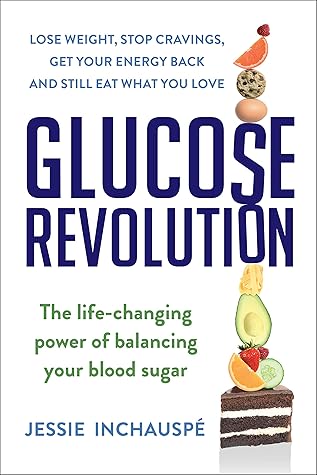More on this book
Community
Kindle Notes & Highlights
Read between
May 14 - May 26, 2023
Humans store extra glucose as glycogen and fat. Extra fructose just turns into
low-density lipoprotein [LDL] or “bad” cholesterol.)
processed foods that are “fat free” often contain a lot of sucrose, so the fructose in it is turned into fat after we digest it.
Too much insulin is the root cause of obesity, type 2 diabetes, polycystic ovarian syndrome (PCOS),
if our glucose levels, and therefore our insulin levels, are steady, we shed pounds.
how I feel right now is intimately linked to the spikes and dips of my glucose curve.
For some, they’re dizziness, nausea, heart palpitations, sweats, food cravings, and stress; for others, like me, they’re exhaustion and brain fog.
for many Glucose Goddess community members, a glucose spike can also bring on poor mood or anxiety.
The big drop in glucose levels was causing me to...
This highlight has been truncated due to consecutive passage length restrictions.
Second, constant hunger is a symptom of high insulin levels.
Leptin, the hormone that tells us we are full and should stop eating, has its signal blocked, while ghrelin, the hormone that tells us we are hungry, takes over.
The more weight we put on, the hungrier we get. It’s an unfortunate, vicious, and unfair cycle.
Flattening our glucose curve leads to fewer cravings.
This will influence not just how old you look externally but how old you are internally.
The more often we spike, the faster we age.
Glycation, free radicals, and the subsequent inflammation are responsible for the slow degradation of...
This highlight has been truncated due to consecutive passage length restrictions.
Alzheimer’s and glucose levels are so closely connected that Alzheimer’s is sometimes called “type 3 diabetes” or “diabetes of the brain.”
people with type 2 diabetes are four times more likely to develop Alzheimer’s than nondiabetics.
Cancer risk Children born today have a one in two chance of developing cancer in their lifetime.
bowel distress—such as leaky gut, irritable bowel syndrome, and slowed intestinal transit—is linked to diet.
gut health is linked to mental health—unhealthy microbiomes can contribute to mood disorders.
what we eat, and whether or not we have glucose spikes, affects how we feel.
half the people who have a heart attack have normal levels of cholesterol.
a specific type of cholesterol (LDL pattern B) as well as inflammation that drive heart disease.
Doctors can better measure heart disease risk by looking at what’s called the triglycerides-to-HDL ratio
Type 2 diabetes is a global epidemic, with half a billion people in the world suffering from the disease and the number rising every year.
the most effective way to reverse type 2 diabetes is to flatten our glucose curves. This is more effective than low-calorie or low-fat diets,
when glycation transforms a molecule of collagen, it makes it less flexible. Collagen is needed to repair wounds, as well as make healthy skin, nails, and hair.
the accumulation of glycated proteins blocks the light and we develop cataracts.
If you could wake up every day and feel amazing, wouldn’t you want to?
You’re about to discover food hacks that will help you flatten your curves, reconnect with your body, reverse your symptoms—while still eating what you love.
soon you’ll wake up one morning and feel amazing.
What is the right order? It’s fiber first, protein and fat second, starches and sugars last.
fiber slows down the breakdown and absorption of any glucose
fiber flattens our glucose curves.
Protein is found in meat, fish, eggs, dairy, nuts, beans, and legumes.
Foods containing fat also slow down gastric emptying, so eating them before rather than after carbs also helps flatten our glucose curves.
The right order to eat foods in: veggies first, protein and fat second, starch last.
Cornell research team showed that if we eat our food in the wrong order (starches and sugars first), ghrelin, our hunger hormone, returns to premeal levels after just two hours.
when we sleep better, we make better choices, and it’s easier to find the motivation to do good for ourselves.
Based on the science, I love any meal that starts with a salad.
dining experiences don’t set us up for success: restaurants serve bread while you’re waiting for food. Starting with starch is the absolute opposite of what you ought to do.
In order to flatten our glucose curves, eating fiber, protein, and fat before starchy foods is key.
fattoush, a traditional Lebanese salad. So off she went to make it herself: she combined chopped bell peppers, cucumbers, tomatoes, and radishes with lettuce, a handful of parsley, spring onions, and seasoned it with olive oil, salt, and a lot of lemon juice.
Only 5 percent of Americans meet the recommended daily amount: 25 grams per day.
Beans, leafy greens, and veggies are great sources of fiber.
One of the reasons a diet high in fruit and vegetables is healthy is because of the fiber it provides.
even if our parents get diabetes, this does not mean that we automatically get it,
She switched from mostly processed foods, made of sugars and starches and devoid of fiber, to mostly whole foods, with lots of fiber.
for breakfast, she has oatmeal with ground flax seeds, hemp seeds, nuts, pea protein powder, and a sausage on the side.


